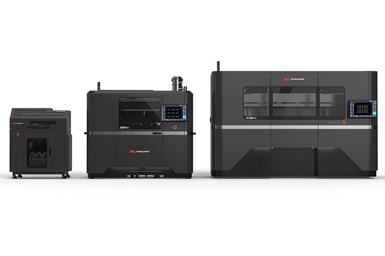Desktop Metal X-Series for Metal, Ceramics Additive Manufacturing
The X-Series is said to offer a differentiated approach to binder jetting enabled by Triple ACT — an advanced compaction technology for dispensing, spreading and compacting powders during the binder jet printing process.
Share
Read Next
Desktop Metal’s X-Series line of binder jet 3D printing systems is capable of additive manufacturing (AM) production with metal and ceramic powders in a wide range of particle sizes.
The X-Series is derived from the company’s acquisition of ExOne in late 2021 and is available with Desktop Metal’s build preparation and simulation software applications. Additionally, the X-Series will now be supported by Desktop Metal’s global support team.
The company says the X-Series offers a differentiated approach to binder jetting enabled by Triple ACT — an advanced compaction technology for dispensing, spreading and compacting powders during the binder jet printing process. It is said this flexible, open material platform architecture is capable of binding together a wide range of powders with a D50 of 3 to 100 microns.
The X-Series comes in three models, including the InnoventX, which is an entry-level binder jet system well suited for academic, R&D, and low-volume production applications. The X25Pro is a midsized solution for volume production, featuring a build box of 400 × 250 × 250 mm (15.75 x 9.84 x 9.84″). The third model is the X160Pro, which the company says is the world’s largest metal binder jet system, featuring a build box of 800 × 500 × 400 mm (31.5 x 19.7 x 15.8″).
The updated line of binder jet 3D printing systems focuses on production of specialty materials, such as ceramics, in addition to metals, with new software capabilities. The company’s binder jet 3D printing platforms work with a variety of material offerings, including metal, ceramic, sand and wood. It is said binder jet 3D printing is regarded as one of the few 3D printing strategies capable of delivering the cost and speed required for high-volume production.
X-Series printers are said to repeatably deliver tight dimensional tolerances and densities of 97-99% or greater — in line with or surpassing metal injection molding or gravity castings. Surface roughness values as low as 4 µm (Ra) can be achieved directly out of the furnace.
Related Content
-
Video: 5" Diameter Navy Artillery Rounds Made Through Robot Directed Energy Deposition (DED) Instead of Forging
Big Metal Additive conceives additive manufacturing production factory making hundreds of Navy projectile housings per day.
-
Additive Manufacturing Is Subtractive, Too: How CNC Machining Integrates With AM (Includes Video)
For Keselowski Advanced Manufacturing, succeeding with laser powder bed fusion as a production process means developing a machine shop that is responsive to, and moves at the pacing of, metal 3D printing.
-
3D Printed Titanium Replaces Aluminum for Unmanned Aircraft Wing Splice: The Cool Parts Show #72
Rapid Plasma Deposition produces the near-net-shape preform for a newly designed wing splice for remotely piloted aircraft from General Atomics. The Cool Parts Show visits Norsk Titanium, where this part is made.















